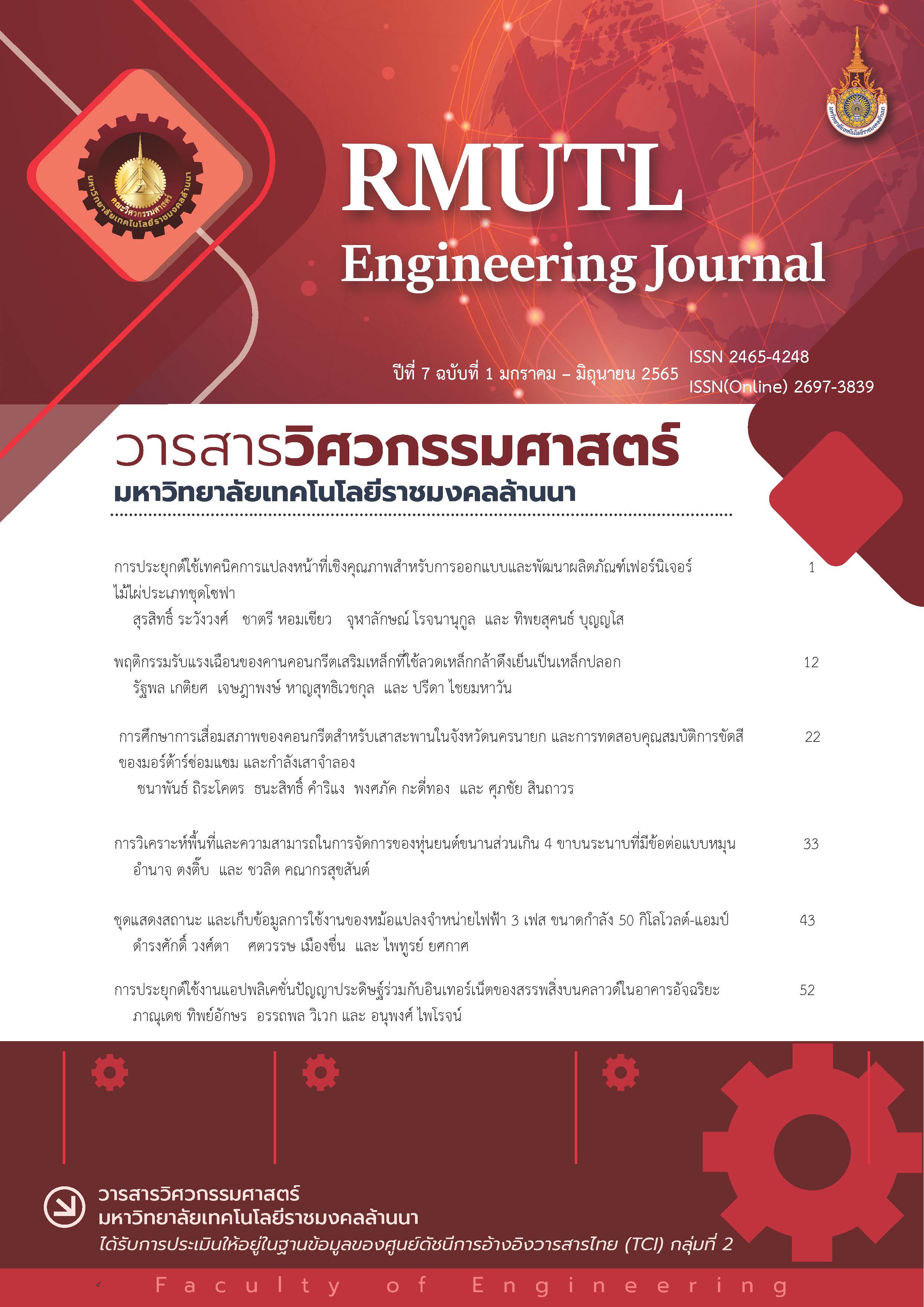Shear Behavior of Reinforced Concrete Beam using Cold-drawn Steel wire Stirrup
DOI:
https://doi.org/10.14456/rmutlengj.2022.2Keywords:
High-strength Stirrups, Reinforced Concrete Beam, Cold Drawn Steel WireAbstract
This paper presents a shear behavior of six reinforced concrete beam having different of transverse reinforcement detailing and material. The test specimens can be divided into two material groups. For the first one, tie stirrup using SR24 grade round bar with 6.0 mm. in diameter was used as transverse reinforcement with spacing distance as 0.125 and 0.375 m. For the other, spring stirrup using 3.3 mm. in diameter cold drawn steel wire according to TIS 747-2531 with spiral spacing as 0.05 0.075 0.125 and 0.20 m. was applied to transverse reinforcement. All test specimens were carefully tested under static loading according to the third-point load testing. The test results showed that shear capacities of the test specimens with tie stirrup, 0.125 m. spacing distance, and spring stirrup, 0.05 and 0.075 m spacing distances were very similar. Furthermore, the failure mode of the specimens was ductile failure.
References
American Concrete Institute. ACI 318-19, Building code requirements for structural concrete. Farmington Hills: MI; 2019.
The Engineering Institute of Thailand under H.M. the King’s Patronage. EIT Standard 1008-38, Building code requirements for reinforced
concrete building by strength method. Bangkok: Thailand; 2021.
Thai Industrial Standards Institute. Tis no.747-2531, Cold-drawn steel wire for concrete reinforcement. Bangkok: Thailand; 1988.
Thai Industrial Standards Institute. Tis no.20-2559, Steel bar for reinforced concrete: round bars. Bangkok: Thailand; 2016.
Li B, Park R, Tanaka H. Stress-strain behavior of high-strength concrete confined by ultra-high-and normal-strength transverse reinforcement J ACI Struct. 2001;98(3):395-406.
Amorn W, Bowers J, Girgis A, Tadros MK. Fatigue of deformed welded-wire reinforcement. J PCI. 2007;52(1):106-20.
American Association of State Highway and Transportation Official. AASHTO LRFD bridge design specification. Washington: DC; 2006.
Lee JY, Lim HS, Kim SE. Evaluation of applicability of high strength stirrup for prestressed concrete members. Int. J Struct Constr Eng 2017;11(6):718-23.
Shin D, Haroon M, Kim C, Lee BS, Lee JY. Shear strength reduction of large-scale reinforced concrete beams with high-strength stirrups. J
ACI Struct 2019;116(5):161-72.
Lee JY, Haroon M, Shin DI, Kim SW. Shear and torsional design of reinforced concrete members with high-strength reinforcement. J
Struct Eng 2021;147(2): 04020327.
Yan S, Xiao X, Zhang Y, Kan L. Seismic performances of square HSC columns confined with high-strength PC rebar. J Shenyang Jianzhu Univ (Natural Science Edition) 2006;22(1):7-10.
NEHRP Consultant Joint Venture. Use of high- strength reinforcement in earthquake-resistant concrete structures. Gaithersburg, MD: NIST U.S.Dept. of Commerce; 2011. Report No.: GCR 14-917-30.
Shi Q, Yang K, Bai L, Zhang X, Jiang W. Experiments on seismic behavior of high- strength concrete columns confined with high-strength stirrups. J China Civil Eng 2011;44(12):9-17.
Ding HY, Liu Y, Han C, Guo YH. Seismic performance of high-strength short concrete column with high-strength stirrups constraints. J Tran Tianjin U 2017;23:360-69.
Zheng W, Hou C, Chang W. Experimental study on mechanical behavior of circular concrete columns confined by high-strength spiral stirrups. J Build Struct 2018;39(6):21-31.
Paultre P. Influence of concrete strength and transverse reinforcement yield strength on behavior of high-strength concrete columns. J ACI Structural 2001;98(4):490-01.
Wang P, Shi Q, Wang F, Wang Q. Seismic behaviour of concrete columns with high-strength stirrups. J Earthquakes and Structures 2020;18(1):15-25.
Thai Industrial Standards Institute. Tis no.24-2559, Steel bar for reinforced concrete: deformed bars. Bangkok: Thailand; 2016.
American Society of Civil Engineers. ASCE/SEI 7-16, Minimum Design Loads and Associated Criteria for Buildings and Other Structures. New York: 2016.
American Association of State Highway and Transportation Official. AASHTO T97-18, Standard Method of Test for Flexural Strength of Concrete (Using Simple Beam with Third-Point Loading). Washington: DC; 2018.
Park R. Evaluation of Ductility of Structures and Structural Assemblages from Laboratory Testing. Bulletin of the New Zealand National Society for Earthquake Engineering 1989;22(3):155-66.
Haddadin MJ, Hong S, Mattock AH. Stirrup effectiveness in reinforced concrete beam with axial force. J Structural Division, ASCE 1971;97(9):2277-98.
Transportation Research Board and National Academes of Sciences, Engineering, and Medicine. Simplified shear design of structural concrete members. Washington, DC: The National Academies Press; 2005. Report No.: 549.
Downloads
Published
How to Cite
Issue
Section
License
Copyright (c) 2022 วารสารวิศวกรรมศาสตร์ มหาวิทยาลัยเทคโนโลยีราชมงคลล้านนา

This work is licensed under a Creative Commons Attribution-NonCommercial-NoDerivatives 4.0 International License.










